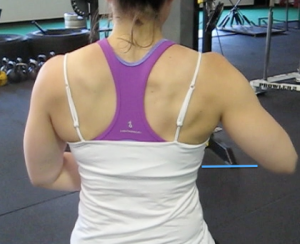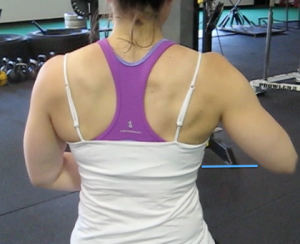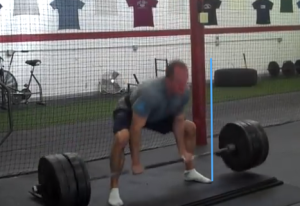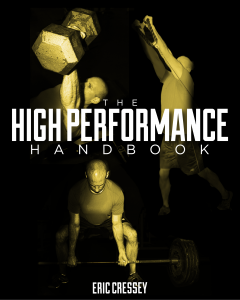
Coaching Cues to Make Your Strength and Conditioning Programs More Effective – Installment 11
In today’s post, I want to cover three more coaching cues you can use to clean up your training technique. These are ones I use all the time with athletes at Cressey Sports Performance:
1. “Create a gap.”
I use this one all the time with both rowing and pressing variations. Athletes love to keep the elbow too close to the side, and it creates an environment of faulty scapular positioning during movement of the upper arm. You can check out examples on my Instagram page, if you’re interested (FAULTY vs. CORRECTED).
The answer is very simple: create a gap between the upper arm and torso. I’ll usually just put my hand between the two landmarks and wiggle my fingers side to side to create a gap, as depicted by the blue line here:

2. “Don’t let this plate fall.”
I’ve written in the past (here) about how much I love bear crawls as everything from a low-level core stability exercise to a great scapular control drill. That said, one thing you’ll see as a common mistake from athletes is that they’ll allow their lower back and hips drift side to side on each “step.” While this is indicative of the need for rotary stability at the core, usually, the problem is still something that can be fixed up pretty quickly with some basic coaching cues, starting with “slow down.”
To build on “slow down” with an external focus cue, I’ll set a 2.5-pound plate on the athlete’s lower back. The more the lumbopelvic region shifts, the more likely it is to fall.
3. “Don’t break the glass.”
One of the biggest mistakes we see with quad dominant athlete who have poor hip hinge patterns is that they’ll break the knee forward in lieu of shifting the hips back. You’ll see this on everything from lateral lunges to the eccentric (lowering) portion of deadlifts.
Obviously, we can start to address this by coaching at the hip (“push your butt back to try to touch the wall behind you”), but you can also have a positive impact on the movement by coaching the knee with an external focus cue of an imaginary pane of glass running directly up to the ceiling from the toes. Check out this still frame I took from the lowering portion of a sumo deadlift. The knee shouldn’t hit the blue line that signifies the imaginary pane of glass:

The image would be more powerful from the side angle, but the plates obscure the lower leg and foot from that perspective, unfortunately. Fortunately, the lateral lunge with overhead reach is a good second shot:

That wraps it up for this edition. Hopefully, you’ve found these cues useful and easy to apply in your strength and conditioning programs. If you’re looking for direction with respect to both programming and coaching cues, be sure to check out The High Performance Handbook, which features more than 200 exercise coaching videos, comprising three hours of footage of the exact cues we use with our athletes.



